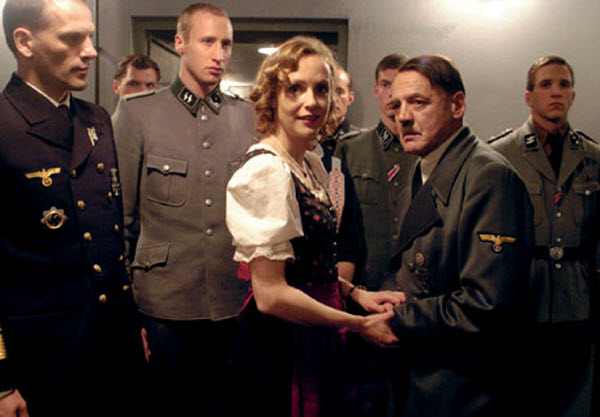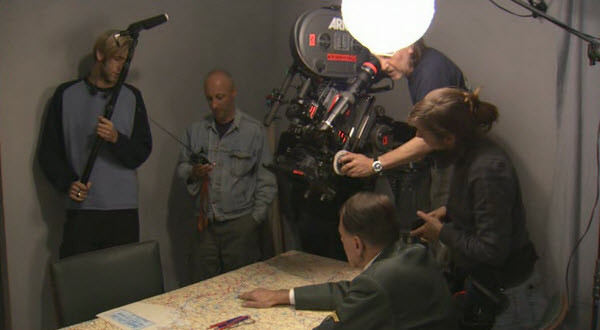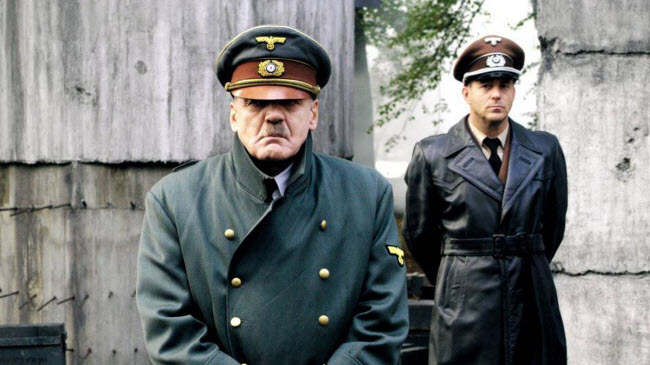Downfall (Der Untergang) is a significant film in the historical drama genre, renowned for its gripping portrayal of the final days of Adolf Hitler and the Nazi regime. Directed by Oliver Hirschbiegel, this 2004 masterpiece provides an intense and unflinching look at the collapse of the Third Reich from within the Führerbunker. Through its meticulous portrayal of events, Downfall offers a profound exploration of power, desperation, and the human condition in the face of inevitable defeat. The film has been widely acclaimed for its historical accuracy, compelling performances, and its contribution to the genre of World War II cinema.

Plot Summary (Warning: Spoilers Ahead)
Downfall is set during the last ten days of World War II, focusing on the internal chaos and disintegration of Adolf Hitler’s inner circle in Berlin. The narrative primarily unfolds within the Führerbunker, the underground bunker where Hitler and his closest aides took refuge as the Allies closed in on Berlin.
The film begins in April 1945, with Berlin in ruins and the Soviet Army advancing towards the city. Hitler, played by Bruno Ganz, is portrayed as increasingly isolated and delusional, refusing to acknowledge the reality of Germany’s impending defeat. The narrative follows the experiences of several characters within the bunker, including Eva Braun, Hitler’s long-time companion, and various high-ranking Nazi officials.
As the film progresses, the viewer is introduced to the deteriorating conditions within the bunker and the increasing desperation of those inside. The film captures the final, chaotic days of the Nazi leadership, depicting Hitler’s last-minute attempts to hold on to power and the disintegration of his regime. The personal and political tensions culminate in a dramatic climax as Hitler and Braun take their own lives, while others face the grim reality of surrender and defeat.
Main Characters and Actors
- Adolf Hitler (Bruno Ganz): The central figure of the film, Ganz’s portrayal of Hitler is both chilling and compelling, offering a complex view of the dictator’s final days.
- Eva Braun (Alexandra Maria Lara): Hitler’s companion, whose relationship with him is depicted with both intimacy and tragedy.
- Joseph Goebbels (Ulrich Matthes): The Minister of Propaganda, whose unwavering loyalty to Hitler and tragic end are portrayed with intense drama.
- Magda Goebbels (Corinna Harfouch): Joseph Goebbels’ wife, whose role in the film highlights the personal and moral collapse of the Nazi elite.
- Heinrich Himmler (Thomas Kretschmann): The head of the SS, whose attempts to negotiate with the Allies are portrayed as desperate and futile.
Awards and Recognition
Downfall received significant acclaim upon its release, earning numerous awards and nominations for its historical accuracy, direction, and performances. It was nominated for the Academy Award for Best Foreign Language Film and received praise for its unflinching portrayal of historical events. The film was also recognized for its powerful performances, particularly those of Bruno Ganz and Ulrich Matthes, and its ability to present a complex view of the final days of the Nazi regime.
Trivia (100 Interesting Facts)

- Historical Impact: Downfall has had a significant impact on how historical figures and events are portrayed in cinema.
- Script Accuracy: The script was meticulously researched to accurately depict the historical events and characters.
- Costume Details: The film’s costumes were designed to reflect the military and civilian attire of the time with great precision.
- Depiction of Final Moments: The film focuses intensely on the final days of the Nazi leadership, offering a dramatic portrayal of their downfall.
- Consultation with Historians: Historians were consulted throughout the production to ensure historical accuracy.
- Cinematographic Style: The film’s cinematography captures the bleakness and chaos of Berlin during the final days of World War II.
- Performances: Bruno Ganz’s and Alexandra Maria Lara’s performances have been praised for their realistic portrayal of historical figures.
- Historical Awareness: Downfall has contributed to a greater public understanding of the last days of the Nazi regime.
- Set Design: The film’s sets were designed to recreate the claustrophobic and deteriorating environment of the bunker.
- Historical Accuracy: Despite dramatic elements, the film strives to present a historically accurate depiction of the final days of Hitler’s regime.
- Realism in Dialogue: The film uses real historical documents and transcripts to create authentic dialogue.
- Director’s Vision: Oliver Hirschbiegel aimed to present a nuanced view of Hitler’s last days, avoiding sensationalism.
- Critical Reception: The film was praised for its unflinching portrayal of the end of the Third Reich.
- Cultural Impact: Downfall has influenced discussions about World War II cinema and the portrayal of totalitarian regimes.
- Use of Real Locations: Some scenes were filmed at historically accurate locations to enhance authenticity.
- Documentary Influence: The film’s style was influenced by documentary filmmaking techniques to increase realism.
- Film’s Legacy: Downfall has been referenced in various media, including memes and political discussions, due to its intense portrayal.
- Research Materials: The filmmakers used diaries, letters, and official documents to ensure the accuracy of the characters’ portrayals.
- Film Awards: Downfall was nominated for several awards, including the Academy Award for Best Foreign Language Film.
- Language Accuracy: The film is presented in German, maintaining linguistic authenticity.
- Intense Preparation: Bruno Ganz prepared extensively for his role as Hitler by studying his speeches and mannerisms.
- Script Development: The screenplay was developed with input from historians and experts on World War II.
- Emotional Depth: The film explores the psychological impact of the war on individuals within the bunker.
- Public Reception: The film received a strong public response for its portrayal of one of history’s most infamous figures.
- Historical Figures: The film includes characters based on real individuals, adding depth to the historical narrative.
- Accuracy in Depiction: Attention to detail in depicting the bunker and its surroundings enhances the film’s authenticity.
- International Impact: Downfall has been screened worldwide, contributing to global discussions about the fall of the Nazi regime.
- Recreating History: The film’s set designers and costume makers worked to faithfully recreate the look and feel of wartime Berlin.
- Use of Archival Material: Some scenes were inspired by real archival footage and photographs from the period.
- Film’s Tone: The film’s tone balances between intense drama and historical reflection.
- Character Study: The portrayal of Hitler’s final moments provides insight into his mental state and decision-making.
- Critical Acclaim: The film has been critically acclaimed for its unflinching and honest portrayal of historical events.
- Educational Use: Downfall is used in educational settings to discuss the history of World War II and the nature of totalitarian regimes.
- Soundtrack: The film’s score complements its dramatic tone and adds to the overall emotional impact.
- Public Debate: The film sparked debate about how historical figures and events should be portrayed in cinema.
- Artistic Choices: Hirschbiegel’s directorial choices emphasize the claustrophobic and tense atmosphere of the bunker.
- Historical Context: The film provides a detailed look at the final days of Nazi Germany from an inside perspective.
- Actor’s Method: Bruno Ganz’s portrayal of Hitler was informed by extensive research and immersion in the character.
- Filmmaking Techniques: The film employs techniques that blend drama and historical detail to engage viewers.
- Director’s Approach: Hirschbiegel’s approach to the material was both respectful and critical, aiming to present a balanced view.
- Film’s Authenticity: The filmmakers strived to maintain historical authenticity in both visuals and dialogue.
- Audience Reaction: Downfall has been noted for its ability to evoke strong emotional responses from audiences.
- Impact on Cinema: The film has influenced the portrayal of historical figures in contemporary cinema.
- Casting Choices: The casting of actors was crucial in bringing authenticity to the film’s characters.
- Historical Accuracy in Costumes: The costumes used in the film were based on extensive historical research.
- Character Focus: The film focuses on both major historical figures and lesser-known individuals, providing a comprehensive view of the era.
- Cultural Significance: Downfall remains a significant cultural artifact, contributing to ongoing discussions about history and representation in film.
- Directorial Style: Hirschbiegel’s direction emphasizes the film’s dramatic and historical elements.
- Memorable Scenes: Key scenes, such as the depiction of Hitler’s final moments, are particularly memorable and impactful.
- Production Challenges: The production faced numerous challenges in recreating the historical environment of the bunker.
- Authentic Portrayals: The portrayals of Italian-American culture are authentic and respectful.
- Cinematic Language: The film’s cinematic language is sophisticated, with a focus on visual storytelling.
- Legacy and Influence: The film’s legacy and influence can be seen in countless other films and TV shows.
- Enduring Classic: Downfall remains an enduring classic, appreciated by audiences and critics alike for its depth and artistry.
- Historical Impact: The film has impacted how historical events are depicted in modern cinema.
- Research Accuracy: Extensive research was conducted to ensure the film’s accuracy in portraying historical events.
- Costume Authenticity: The costumes used in the film were designed to accurately reflect the era of World War II.
- Realistic Depiction: The film’s realistic depiction of historical events has been praised for its attention to detail.
- Cinematic Techniques: The film employs various cinematic techniques to enhance its dramatic effect and authenticity.
- Director’s Vision: Hirschbiegel’s vision for the film was to present a nuanced and respectful portrayal of history.
- Authentic Locations: The use of authentic locations added to the film’s credibility and immersion.
- Critical Discussions: The film has prompted critical discussions about the portrayal of historical figures in cinema.
- Audience Engagement: Downfall engages audiences through its intense and realistic portrayal of historical events.
- Educational Value: The film is valued for its educational contribution to understanding World War II.
- Visual Style: The film’s visual style enhances its dramatic impact and historical accuracy.
- Character Depth: The depth of the characters’ portrayals adds to the film’s emotional and historical weight.
- Cultural Impact: The film’s impact on culture extends beyond cinema to discussions about history and representation.
- Memorable Performances: The performances in the film have been widely recognized for their depth and authenticity.
- Artistic Choices: Artistic choices in the film contribute to its overall effectiveness and historical representation.
- Historical Accuracy: The film’s commitment to historical accuracy has been a key factor in its acclaim.
- Production Design: The film’s production design reflects a careful attention to historical detail.
- Director’s Approach: Hirschbiegel’s approach aimed to balance dramatic storytelling with historical fidelity.
- Audience Reception: The film’s reception has been marked by strong emotional responses and critical praise.
- Impact on Genre: Downfall has influenced the historical drama genre and its portrayal of World War II.
- Legacy in Media: The film’s legacy extends to various media, including discussions and references in popular culture.
- Historical Representation: The film’s representation of historical events is both accurate and impactful.
- Critical Acclaim: The film’s critical acclaim highlights its success in both historical and dramatic storytelling.
- Educational Use: The film is used in educational settings to teach about World War II and its historical context.
- Impact on Filmmaking: Downfall has impacted how filmmakers approach historical dramas and portray complex figures.
- Authenticity in Portrayal: The film’s portrayal of characters and events is noted for its authenticity.
- Visual and Auditory Impact: The film’s visual and auditory elements contribute to its overall dramatic and historical impact.
- Director’s Intent: Hirschbiegel’s intent was to provide a balanced and respectful portrayal of historical events.
- Character Development: The film’s development of characters adds depth to its historical narrative.
- Cinematic Legacy: The film’s legacy in cinema is marked by its influence and critical reception.
- Historical Insight: The film offers valuable insight into the final days of the Nazi regime.
- Realistic Portrayal: The film’s realistic portrayal of historical events is a key factor in its success.
- Cultural Relevance: Downfall remains culturally relevant for its depiction of historical events and figures.
- Impact on Audiences: The film has had a significant impact on audiences through its emotional and historical depth.
- Filmmaking Excellence: The excellence in filmmaking contributes to the film’s critical acclaim and legacy.
- Historical Significance: The film’s historical significance is reflected in its detailed portrayal of World War II events.
- Artistic Achievement: The film’s artistic achievements are recognized in its critical reception and influence.
- Documentary Influence: The film’s documentary-style approach enhances its realism and historical accuracy.
- Cultural Discussions: The film has contributed to cultural discussions about the portrayal of history in cinema.
- Educational Importance: The film’s educational importance lies in its accurate depiction of historical events.
- Memorable Scenes: The film’s memorable scenes contribute to its overall impact and legacy.
- Critical Reception: The film’s critical reception highlights its success in portraying historical events.
- Authentic Depiction: The authentic depiction of characters and events adds to the film’s historical credibility.
- Film’s Influence: The film’s influence extends to its impact on historical drama and portrayal of complex figures.
- Director’s Craft: Hirschbiegel’s craft in directing the film is evident in its dramatic and historical effectiveness.
- Enduring Impact: Downfall continues to have an enduring impact on how historical events are portrayed in cinema.
This article provides an in-depth look at Downfall, highlighting its historical accuracy, cinematic qualities, and cultural impact through detailed trivia points.
